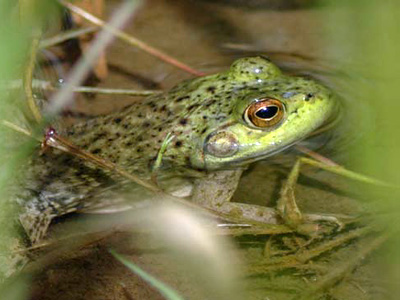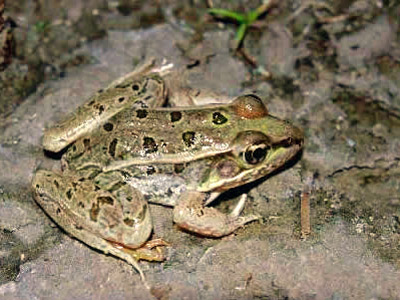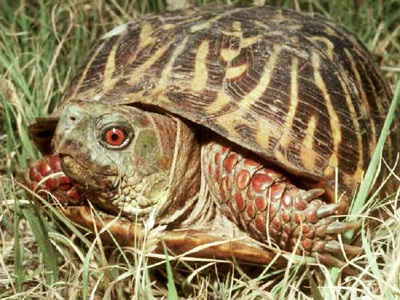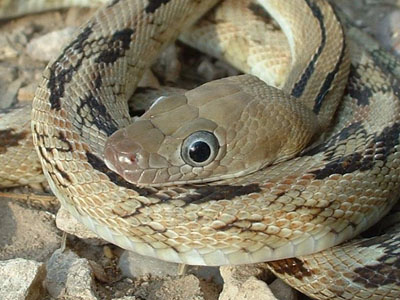Declines in amphibian and reptile populations have been and are being observed. Herpetofauna across the globe face threats from both known and unknown sources (Gibbons et al. 2000). Disease may now be as great a cause of amphibian decline as habitat destruction. Potential causes of herpetofauna decline in the Southwest include habitat loss and degradation, invasive species, drought, legal and illegal collecting, disease, and other causes (e.g., chemical contamination, ultraviolet radiation).
Habitat Loss and Degradation
Habitat loss and degradation is one of the greatest threats to amphibian and reptile populations. Habitat loss/degradation occurs from a variety of sources, including urban/suburban development, aquatic habitat alteration from water withdrawals and stream diversions, water pollution, and off-road vehicle use in terrestrial habitats. Declines in both population levels and species diversity have been attributed to habitat loss and degradation. Development can negatively affect habitat by destroying sites or degrading their quality, and by creating barriers or hazardous zones (e.g., a road) between important habitat features. Loss and degradation of habitat can disrupt population connectivity, diminishing the rate of dispersal and recolonization such that local populations are unable to persist through natural catastrophes or population fluctuations. Urban development also increases conflicts between venomous species and humans (Sullivan et al. 2004, Nowak et al. 2002).
Many studies have reported high rates of amphibian and reptile mortality on roads. Amphibian populations are most susceptible to high rates of road-kill when migrating en masse between habitat patches. Reduced anuran density and population abundance, lower probabilities of occurrence, and adverse population genetic effects have been attributed to roads. Reptiles, such as snakes, sometimes prefer sunning on warm, smooth surfaces such as roads. A year-long study in a Texas wildlife management area found road traffic affected reptiles extensively in the fall and spring and amphibians in the spring and summer. In the spring, 83% of amphibians observed were found dead on the road (Coleman et al. 2008).
Invasive Species

Kelly Mcallister
Non-native invasive species are another threat to herpetofauna populations. Non-native invasive species may act as predators of or competitors with native species. Bullfrogs (Rana catesbeiana), for example, occur in at least two parks in the CHDN (Carlsbad Caverns and Big Bend NPs; Prival and Goode [2005]). At Carlsbad Caverns NP, the bullfrog has been documented and studied at Rattlesnake Springs (Krupa 1998). At this location, the non-native was found to out-number the Rio Grande leopard frog (Rana berlandieri) 50% of the time in the spring pool and on every occasion counted in the stream (at ratios of 7:1 to 20:1). A Rio Grande leopard frog or tadpole was found in only a few bullfrog stomachs (out of ~85 bullfrogs collected), but the analysis showed that the bullfrogs do consume leopard frogs. Adult leopard frogs captured during the study were either young, newly transformed adults or large, old adults; middle size classes were missing, possibly due to predation by bullfrogs (Krupa 1998). At Big Bend NP, bullfrogs have been found along the Rio Grande and in the Beaver Pond at Rio Grande Village (Dayton 2005), but not in the interior of the park. A non-native treefrog, Hyla cinerea, native to southeastern North America, was recently discovered at Big Bend NP. The frogs are currently found in/around two ponds in the park (Beaver Pond and Spring 4 Pond in Rio Grande Village) and are consuming a variety of terrestrial arthropods (Leavitt and Fitzgerald 2009).

Jim Rorabaugh / USFWS
Non-native fish can also be a major problem for native aquatic amphibians and reptiles. Non-native fish compete with or eat native fish that are needed by the herpetofauna species, or they may eat the herpetofauna themselves. In Carlsbad Caverns NP, non-native green sunfish (Lepomis cyanellus), as well as largemouth bass (Micropterus salmoides) and Western mosquitofish (Gambusia affinis) have been found in the pond and natural channel at Rattlesnake Springs (Krupa 1998; Carlsbad Caverns NP 2007). Krupa stated in 1998 that if the green sunfish (the largemouth bass was not there at the time) was to establish in the spring pool it could adversely impact the Rio Grande leopard frog by consuming tadpoles. A project was undertaken in 2007 to remove the exotics from the pond, pool, irrigation ditch, and natural channel, and more than 150 fish were removed (Carlsbad Caverns NP 2007). After the project Rio Grande leopard frogs and their egg masses, as well as freely swimming native fish, were observed in the pond.
A non-native reptile known to occur in the CHDN is the Mediterranean gecko (Hemidactylus turcicus) (Prival and Goode 2005). It has been found in at least two of the parks in the network (Amistad NRA and Big Bend NP). Occurring throughout urban areas in the southern U.S., this species was first observed at Amistad after 1977 (Prival and Goode 2005). Although it is commonly found on buildings near lights (where it is attracted by insects), it is found on natural cliff faces at Amistad NRA. At the present time, this non-native species is not thought to threaten native species.
The introduction of non-native plant species may threaten some reptiles. Alteration of habitat (e.g., changes in habitat structure and native plant community composition) has negatively affected the desert tortoise (Gopherus agassizii) in the Sonoran Desert. The increase of invasive plants (e.g., red brome [Bromus rubens] and buffelgrass [Pennisetum ciliare]) has led to increased fire frequencies, to which the tortoise and the plants/habitat upon which it depends are not well-adapted (Esque 2003). A recent study in Big Bend NP found that non-native plants are becoming more abundant in some areas studied. The plants found that are of most concern are buffelgrass, King Ranch bluestem (Bothriochloa ischaemum), Johnson grass (Sorghum halepense) and Lehmann lovegrass (Eragrostis lehmanniana) (Leavitt 2007). Leavitt recommends that future research should consider the impacts of non-native plants on the diversity and density of herpetofauna.
Drought

Colorado Parks & Wildlife
Amphibian and reptile populations are sensitive to fluctuations in the amount and timing of precipitation. Drought has been implicated as the cause of drastic declines in frog populations. In addition to direct effects on survival and reproduction, drought can adversely affect amphibians by interacting with other factors, such as disease, UV-B radiation, and exposure to contaminants. Although drought is a natural phenomenon, climate changes including drought could be occurring faster than organisms can adjust. Climate change is cited consistently as one of the main potential causes of amphibian population declines. Temperatures have increased 0.8 degrees celcius in the West since the 1950s, and they are predicted to rise by 2-5 degrees in the next century (Hansen et al. 2001). Drought frequency is predicted to increase by 66-90% (Gitlin et al. 2006).
Drought adversely affects amphibians because of their dependence on pooled surface water for reproduction. When a breeding pond dries up prior to the onset of metamorphosis, the entire reproductive effort for the year is lost. At ponds reduced in size because of drought, an increase in larval density can negatively influence larval survival by slowing development. In addition, pond drying can result in early metamorphosis, which is linked to small body size and decreased survival rates in juvenile frogs. Post-metamorphic amphibians that use terrestrial habitats for non-breeding activities can also be adversely affected by drought. The loss of body water through evaporation must be offset through absorption of water from wet or moist substrates. Amphibians must rehydrate frequently, as death results from desiccation. Amphibians crowded into limited habitat also may be more subject to disease or parasite epidemics.
Drought impacts desert reptiles because there is less free water for them and their prey. Prey numbers typically decline during drought, and many reptiles rely on their diets to obtain water. If they can not drink free water, they may die from desiccation if they can not eat enough. A behavior of some reptiles, which may be especially important for survival in the desert where rainwater may not accumulate (Repp and Schuett 2008), is that of harvesting and drinking water from their own bodies (e.g., from a pool of water within a snake’s coils). Repp and Schuett (2008) reported on western diamond-backed rattlesnakes (Crotalus atrox) harvesting and drinking rainwater during an extended drought.
Legal and Illegal Collecting

Dave Prival / NPS
Legal and/or illegal collecting of herpetofauna may also affect some populations within the Chihuahuan Desert region, although the magnitude of this problem is unclear (in part due to a lack of information on the collection and sale of nongame species). For instance, based on data for Texas in 1999, nearly 5,000 amphibians and nearly 10,000 reptiles (not including rattlesnakes for rattlesnake roundups) were reported to be collected by 53 nongame permit holders (Fitzgerald et al. 2004). With regard to international trade in reptiles from the Chihuahuan Desert region in the U.S., Fitzgerald et al. (2004) note that the export of live snake and lizard species does not appear to be of significant concern, but that the trade in parts or products of a small number of species may be of greater concern. The trade in parts or products is more likely to involve wild-caught adult animals, including venomous species. The Western diamond-backed rattlesnake, for example, is exported in various forms, particularly as meat. Although collection and trade may not be a significant threat for the majority of herpetofauna species in the Chihuahuan Desert region of the U.S., over-collecting may be impacting local populations of some species with particular vulnerabilities and/or life history characteristics (e.g., those that are long-lived, have a low reproductive rate, or with fragmented ranges; Fitzgerald et al. 2004).
Diseases
Chytridiomycosis
The disease chytridiomycosis is caused by a recently identified species of parasitic fungus (Batrachochytrium dendrobatidis), known as the amphibian chytrid fungus. Chytridiomycosis is considered a major threat to amphibians worldwide, causing population declines and species extinctions. Much remains unknown about the disease. The water-dependent fungus attacks amphibian skin and is believed to be able to persist in aquatic environments without amphibians. Amphibian larvae are not lethally affected, but they can carry the fungus in mouthparts and toe tips during later stages of development. Some amphibian species can carry the fungus without being killed by it, and they may serve as vectors of the pathogen to more susceptible species. The responses of amphibian populations infected with the fungus range from no perceptible impact, to mass mortality events, to severe decline without recovery. Reports of the disease in the Southwest include infections in lowland leopard frogs (Rana yavapaiensis), Chirichahua leopard frogs (Rana chiricahuensis), and canyon tree frogs (Hyla arenicolor) in eastern, central, and southern Arizona (Bradley et al. 2002). The disease has also been detected in Texas (Gaertner et al. 2009).
Ranavirus
The genus Ranavirus (family Iridoviridiae), only recently discovered, causes disease in amphibians, reptiles, and fish. Amphibian ranaviruses are considered a global threat to amphibian populations due to their high virulence and rapid expansion to areas with previously unexposed populations. Ranavirus is associated with mass mortalities in amphibians, particularly larvae and recently metamorphosed juveniles, with death rates reaching 100%. Death is thought to result from organ failure due to tissue necrosis and possibly from secondary bacterial infections. Ranavirus can be spread in various ways, including
Other Potential Threats
Because pollutants have reduced the thickness of the protective ozone layer in the atmosphere, increased amounts of ultraviolet (UV) radiation are reaching the Earth’s surface. UV radiation levels have increased substantially over the last 30 years, with most of the increase occurring in the mid- and high-latitudes (NASA 2010). Amphibians may be more vulnerable to harmful effects of UV radiation than other kinds of animals due to their “naked” skin and shell-less eggs. Adverse effects of UV-B include interference with intracellular functions, impaired transcription of DNA, and interactions with chemicals that make them more toxic. Field and laboratory studies have demonstrated increased mortality, deformities, and susceptibility to fungal disease. There is debate over whether or not UV-B is a main factor in currently observed amphibian declines, but researchers share concern about ozone depletion and the consequences of increasing levels of UV-B. Of particular concern is the potential for UV-B to interact in complex ways with contaminants, climate (e.g., drought), and disease.
Chemical contaminants come from many sources and can have direct and indirect effects on herpetofauna (Gibbons et al. 2000). Amphibians may be exposed to chemical hazards through direct uptake from water or by ingestion of contaminants in soils, sediments, and food items. They may be unusually susceptible to toxins due to their permeable skin and protracted development in the aquatic environment. Many aquatic snakes and other aquatic/semi-aquatic reptiles may also be susceptible to contaminants. Knowledge about the effects of contaminants on amphibians is scarce, and reptiles have been studied even less (Gibbons et al. 2000). Effects of contaminants on reptiles are known primarily from observations of turtles and crocodilians.
Increased temperatures resulting from climate change could affect some reptiles and amphibians. Evidence for effects on freshwater turtles includes increased juvenile growth rates, earlier ages at maturity, and changes in sex ratios (Frazer et al. 1993). Crocodilians and some turtles may be affected the most, because of their temperature-dependent sex determination. Altered sex ratios could affect population demographics and persistence. Reptiles and amphibians could also be affected by climate change if changes occur in hibernation periods. The absence of a long hibernation period could result in starvation over the winter or changes in gonadal development. An increase in summer temperatures could render burrows unusable and result in desiccation.
Part of a series of articles titled Amphibians and Reptiles in the Chihuahuan Desert.
Previous: Ecology
Tags
Last updated: February 23, 2017
